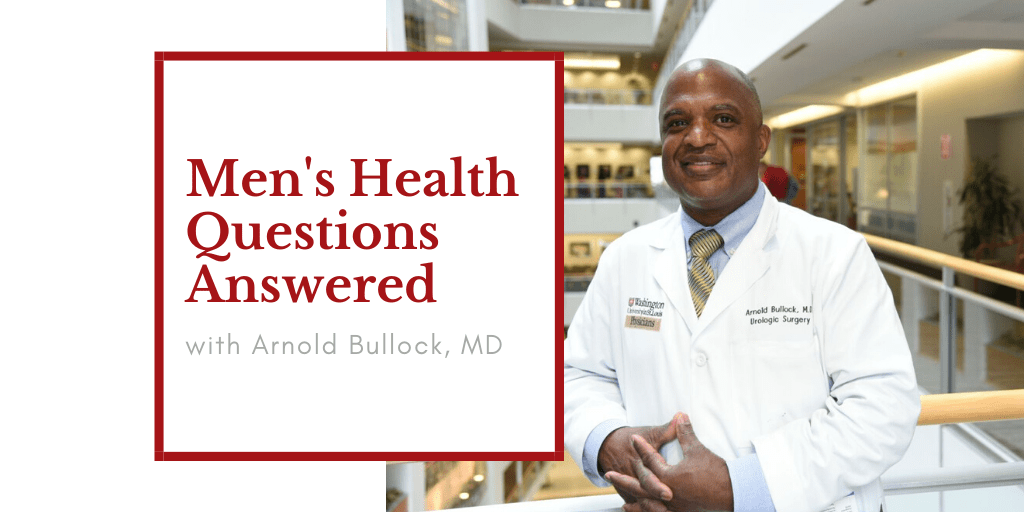Men’s health topics are important to discuss with a doctor, but for many men it is difficult to have these conversations with their health care provider. Discussing sex, prostate health and hormonal imbalance can be uncomfortable, but understanding these and other conditions, and how they affect overall health, is critically important for every man.
Arnold Bullock, MD, Professor of Urologic Surgery at Washington University School of Medicine in St. Louis specializes in men’s health. He encourages men to ask their questions and engage in honest conversations with their doctors. To help start this conversation, Bullock explains some of the common causes of voiding dysfunction.
What is Voiding Dysfunction?
Voiding dysfunction is a condition affecting your ability to urinate. Depending on the cause, voiding dysfunction can lead to urinary incontinence or the inability to fully empty your bladder.
A quarter of my practice is devoted to male voiding dysfunction. There are two main complaints I hear from men with voiding dysfunction:
- “Doc, when I gotta go, I gotta go right now. And if I can’t make it to the bathroom, I need to wear a pad.”
- “I get up 5-6 times a night to pee, feeling like I really had to go, but all I go is 3 ounces. I have to bear down, I have to strain, I have to push. It stops and starts. I know I’m not emptying my bladder, because 20-30 minutes later I have to go again.”
Both of these complaints have to do with voiding dysfunction, but they have two different causes, and need to be treated differently. At the School of Medicine, we have treatment options for both of these types of voiding dysfunction. A person should not have to struggle with wearing a pad or getting up repeatedly throughout the night to urinate when there are treatment opportunities for correcting their condition.
“When I gotta go, I gotta go right now.”
This is a symptom of an overactive bladder. The bladder is part of your urinary system. It receives the urine from your kidneys. Urine comes from the kidneys down the ureters to your bladder, and the urine then leaves the bladder and exits the body through the urethra.
With bladder control problems, the bladder might be too active or the pelvic muscles might not be strong enough to hold back the urine until you’re ready to go. These problems can usually be easily treated with medicine. A man can take one pill each night and see results within a couple of weeks, fixing his overactive bladder without the need for any invasive procedures. Getting the right diagnosis from a urologic specialist is an important first step to treating an overactive bladder.
“It stops and starts. I know I’m not emptying my bladder.”
This is a symptom of an obstructive prostate. Men who have an obstructive prostate rarely leak on themselves, and do not have to race to the bathroom, but they feel like they can’t fully void when they go to urinate. That’s the main difference between obstructive prostate symptoms and overactive bladder symptoms.
Men have a prostate gland, which is an accessory sex organ that sits just below the urinary bladder. When urine leaves the bladder, it flows right through the middle of your prostrate before exiting through the urethra. If the prostate is enlarged, this can cause an obstruction, blocking the urine from exiting the bladder.
An enlarged prostate, also known as benign prostatic hyperplasia (BPH), is just a larger than usual prostate. This is a common condition, and can be treated with medication, such as alpha-blockers, to relax your prostate so that you urinate better. BPH is nothing to be afraid of. All it means is your prostate is larger than other men’s. Getting this checked by a urologist is important, because we can make sure it’s benign, and not cancerous.
Why See a Washington University Urologist for Voiding Dysfunction?
The key to treating male voiding dysfunction is making the right diagnosis.
Is it a problem with the bladder failing to store urine, or is it a problem caused by an enlarged prostate? Making the correct diagnosis will help us find the best treatment options for your voiding dysfunction. Now, a man could have both an overactive bladder and BPH. In that case, seeing a Washington University Urologist ensures you’re getting treatment for all of your conditions.
There are products advertised on TV that can be deceptive for patients with voiding dysfunction. If you look at the back of the bottle to see what’s in it, you’ll see vitamin B, vitamin D, zinc and ginseng. These are the same things you see in a men’s formula vitamin, so spending $80-90 a month on these supplements is kind of a hoax. They don’t say they are proven to reduce your prostate volume. They don’t say they are proven to allow you to void better. If they did, they would be claiming to be a drug.
It’s so much better to see a specialist, get objective data and numbers, and find out what your problem is. We will run the right tests to make sure you don’t have prostate cancer or bladder tumors, and you will be treated using all of the technology that medicine now affords us.
Management of Overactive Bladder and Urinary Incontinence Patient Webinar
On November 11th, Henry Lai, MD, will host a complimentary webinar dedicated to the management of an overactive bladder and urinary incontinence. Join him as he explains the innovative treatments he provides for urinary incontinence and bladder issues in both men and women.
